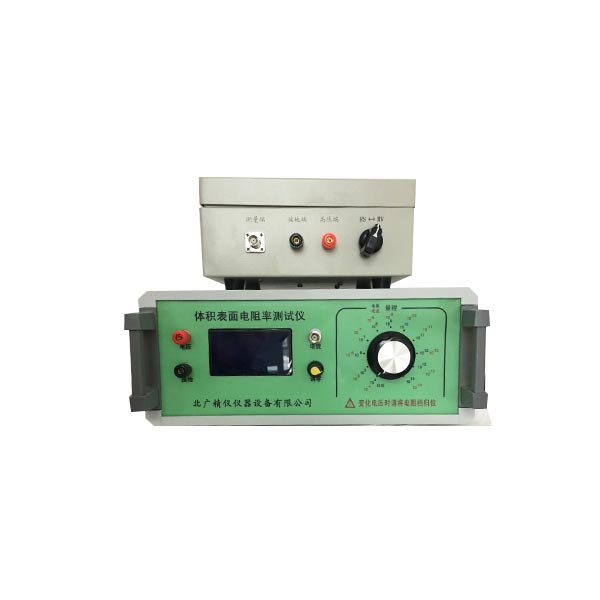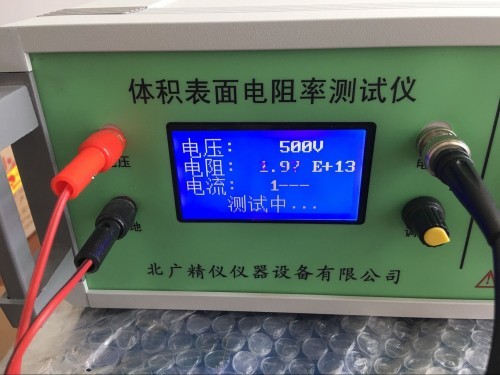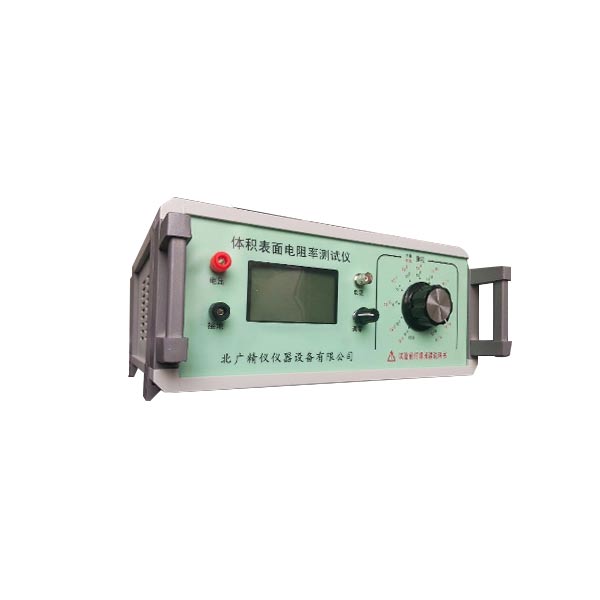
價(jià)格:38450元瀏覽:72次聯(lián)系:劉元元 / 15132636097 / 企業(yè):北京北廣精儀儀器設(shè)備有限公司留言店鋪收藏
防靜電塑料橡膠制品表面電阻率測(cè)定儀 本儀器既可測(cè)量高電阻,又可測(cè)微電流。采用了美國Intel公司的大規(guī)模集成電路,使儀器體積小、重量輕、準(zhǔn)確度高。以雙3.1/2位數(shù)字直接顯示電阻的高阻計(jì)和電流。量限從1?104Ω ~1?1018Ω,是目前國內(nèi)測(cè)量范圍 寬,準(zhǔn)確度 高的數(shù)字超高阻測(cè)量?jī)x。電流測(cè)量范圍為2?10-4~1?10-16A。機(jī)內(nèi)測(cè)試電壓為10/50/100/250/500/1000V任意可調(diào)。本儀器具有精度高、顯示迅速、性好穩(wěn)定、讀數(shù)方便, 適用于防靜電產(chǎn)品如防靜電鞋、防靜電塑料橡膠制品、計(jì)算機(jī)房防靜電活動(dòng)地板等電阻值的檢驗(yàn)以及絕緣材料和電子電器產(chǎn)品的絕緣電阻測(cè)量。本儀器除能測(cè)電阻外,還能直接測(cè)量微弱電流。
This instrument can measure both high resistance and micro current. Adopting large-scale integrated circuits from Intel Corporation in the United States, the instrument has a small size, light weight, and high accuracy. A high resistance meter that displays resistance and current directly using double 3.1/2 digits. The measurement limit ranges from 1?104Ωto 1?1018Ω, making it a widely used and highly accurate digital ultra-high resistance measuring instrument in China. The current measurement range is 2?10-4 to 1?10-16A. The test voltage inside the machine can be adjusted to any of 10/50/100/250/500/1000V. This instrument has high accuracy, fast display, good stability, and convenient reading. It is suitable for testing the resistance values of anti-static products such as anti-static shoes, anti-static plastic and rubber products, anti-static raised floors in computer rooms, as well as measuring the insulation resistance of insulation materials and electronic and electrical products. This instrument can not only measure resistance, but also directly measure weak currents.
防靜電塑料橡膠制品表面電阻率測(cè)定儀 典型應(yīng)用
1.測(cè)量防靜電鞋、導(dǎo)電鞋的電阻值
2、測(cè)量防靜電材料的電阻及電阻率
3、測(cè)量計(jì)算機(jī)房用活動(dòng)地板的系統(tǒng)電阻值
4、測(cè)量絕緣材料電阻(率)
5、光電二極管暗電流測(cè)量
6、物理,光學(xué)和材料研究
Typical applications
1. Measure the resistance value of anti-static shoes and conductive shoes
2. Measure the resistance and resistivity of anti-static materials
3. Measure the system resistance value of the raised floor used in the computer room
4. Measure the resistance (rate) of insulation materials
5. Measurement of Dark Current in Photodiodes
6. Physics, Optics, and Materials Research
電源
要求有很穩(wěn)定的直流電壓源。這可用蓄電油或一個(gè)整流穩(wěn)壓的電摞來提供。對(duì)電源的穩(wěn)定度要求是由電壓變化導(dǎo)致的電流變化與被測(cè)電流相比可忽略不計(jì)。
加到整個(gè)試樣上的試驗(yàn)電壓通常規(guī)定為100V、250V、500V、1000 V、2500 V、5000 V, 10000 V和15000 V。 常用的電壓是100V、500V和1000 V。
在某些情況下,試樣的電阻與施加電壓的極性有關(guān)
如果電阻是與極性有關(guān)的,則宜加以注明。取兩次電阻值的幾何平均值(對(duì)數(shù)算術(shù)平均值的反對(duì)數(shù))作為結(jié)果。
由于試樣電阻可能與電壓有依存關(guān)系,因此應(yīng)在報(bào)告中注明試驗(yàn)電壓值。
Power Supply
Require a very stable DC voltage source. This can be provided by storing oil or a rectifier stabilized stack of electricity. The stability requirement for the power supply is that the current variation caused by voltage changes can be ignored compared to the measured current.
The test voltage applied to the entire sample is usually specified as 100V, 250V, 500V, 1000V, 2500V, and 5000V, 10000 V and 15000 V. The commonly used voltages are 100V, 500V, and 1000V.
In some cases, the resistance of the sample is related to the polarity of the applied voltage
If the resistance is polarity dependent, it should be noted. Take the geometric mean of two resistance values (the inverse of the logarithmic arithmetic mean) as the result.
Due to the possible dependence of sample resistance on voltage, the test voltage value should be indicated in the report.
標(biāo)準(zhǔn)配置:
1,測(cè)試儀器:1臺(tái)
2,電源線:1條
3,測(cè)量線:3根(屏蔽線,測(cè)試接線,接地線)
4,使用說明書:1份
Standard configuration:
1. Testing instrument: 1 unit
2. Power cord: 1
3. Measurement wires: 3 wires (shielded wire, test wire, grounding wire)
4. User manual: 1 copy
測(cè)試電壓(V)
DC—10V
DC—50V
DC—100V
DC—500V
DC—1000V
方法
測(cè)量高電阻常用的方法是直接法或比較法。
直接法是測(cè)量加在試樣上的直流電壓和流過它的電流(伏安法)而求得未知電阻。
比較法是確定電橋線路中試樣未知電阻與電阻器已知電阻之間的比值,或是在固定電壓下比較通過這兩種電阻的電流。
附錄A給出了描述這些原理的例子。
伏安法需要一適當(dāng)精度的伏特表,但該方法的靈敏度和度主要取決于電流測(cè)量裝置的性能,該裝置可以是一個(gè)檢流計(jì)或電子放大器或靜電計(jì)。
電橋法只需要一靈敏的電流檢測(cè)器作為零點(diǎn)指示器,測(cè)量度主要取決于已知的橋臂電阻器,這些橋臂電阻應(yīng)在寬的電阻值范圍內(nèi)具有高的精密度和穩(wěn)定性。
電流比較法的度取決于已知電阻器的度和電流測(cè)量裝置,包括與它相連的測(cè)量電阻器的穩(wěn)定度和線性度。只要電壓是恒定的,電流的確切數(shù)值并不重要。
對(duì)于不大于1011Ω的電阻,可以按照11.1用檢流計(jì)采用伏特計(jì)一安培計(jì)法來測(cè)定其體積電阻率。 對(duì)于較高的電阻,則推薦使用直流放大器或靜電計(jì)。
在電橋法中,不可能直接測(cè)量短路試樣中的電流(見11.1)。
利用電流測(cè)量裝置的方法可以自動(dòng)記錄電流,以簡(jiǎn)化穩(wěn)態(tài)測(cè)試過程(見11.1)。
現(xiàn)己有測(cè)量高電阻的一些專門的線路和儀器。只要它們有足夠的度和穩(wěn)定度,且在需要時(shí)能使試樣短路并在電化前測(cè)量電流者,均可使用。
method
The commonly used methods for measuring high resistance are direct method or comparative method.
The direct method is to measure the DC voltage applied to the sample and the current flowing through it (volt ampere method) to obtain the unknown resistance.
The comparative method is to determine the ratio between the unknown resistance of the sample in the bridge circuit and the known resistance of the resistor, or to compare the current passing through these two resistors at a fixed voltage.
Appendix A provides examples to describe these principles.
The volt ampere method requires a voltmeter of appropriate accuracy, but the sensitivity and accuracy of this method mainly depend on the performance of the current measuring device, which can be a galvanometer, electronic amplifier, or electrostatic meter.
The bridge method only requires a sensitive current detector as a zero point indicator, and the measurement accuracy mainly depends on the known bridge arm resistors, which should have high precision and stability over a wide range of resistance values.
The degree of current comparison method depends on the known degree of the resistor and the current measuring device, including the stability and linearity of the measuring resistor connected to it. As long as the voltage is constant, the exact value of the current is not important.
For resistors not exceeding 1011Ω, the volume resistivity can be measured using a voltmeter ammeter method according to 11.1. For higher resistance, it is recommended to use a DC amplifier or an electrostatic meter.
In the bridge method, it is not possible to directly measure the current in the short-circuit specimen (see 11.1).
The method of using a current measuring device can automatically record the current to simplify the steady-state testing process (see 11.1).
There are now some specialized circuits and instruments for measuring high resistance. As long as they have sufficient degree and stability, and can short-circuit the sample and measure the current before electrification when needed, they can be used.
表面電阻surface resistance
在試樣的其表面上的兩電極間所加電壓與在規(guī)定的電化時(shí)間里流過兩電極間的電流之商,在兩電
極上可能形成的極化忽略不計(jì)。
注1:除 非 另 有 規(guī) 定 ,表 面 電 阻 是 在 電 化 一 分 鐘 后 測(cè) 定
注2通常電流主要流過試樣的一個(gè)表面層,但也包括流過試樣體積內(nèi)的成分
報(bào)告
報(bào)告應(yīng)至少包括下述情況:
a)電阻率測(cè)試儀(電阻率測(cè)定儀)關(guān)于材料的說明和標(biāo)志(名稱、等級(jí)、顏色、制造商等);
b)電阻率測(cè)試儀(電阻率測(cè)定儀)試樣的形狀和尺寸;
c)電阻率測(cè)試儀(電阻率測(cè)定儀)電極和保護(hù)裝置的形式、材料和尺寸;
d)電阻率測(cè)試儀(電阻率測(cè)定儀)試樣的處理(清潔、預(yù)干燥、處理時(shí)間、濕度和溫度)等;
e)電阻率測(cè)試儀(電阻率測(cè)定儀)試驗(yàn)條件(試樣溫度、相對(duì)由度);
f)電阻率測(cè)試儀(電阻率測(cè)定儀)測(cè)量方法;
g)電阻率測(cè)試儀(電阻率測(cè)定儀)施加電壓;
h)電阻率測(cè)試儀(電阻率測(cè)定儀)體和、電阻率(需要時(shí));
注1:當(dāng)規(guī)定了一個(gè)固定的電化時(shí)間時(shí),注明此時(shí)間,給出個(gè)別值,并報(bào)告中值作為體積電阻率。
注2: 當(dāng)在不同的電化時(shí)間后測(cè)試時(shí),應(yīng)按如下要求報(bào)告:
當(dāng)在相同的電化時(shí)間里試樣達(dá)到一個(gè)穩(wěn)定狀態(tài)肘,給出個(gè)別值,并報(bào)告中值作為體積電阻率。在這個(gè)電化時(shí)間里有某些試樣不能達(dá)到穩(wěn)定狀態(tài),則報(bào)告不能達(dá)到穩(wěn)定狀態(tài)的試樣數(shù),并分別地給出它們的結(jié)果。當(dāng)測(cè)試結(jié)果取決于電化時(shí)間時(shí),則報(bào)告它們之間的關(guān)系,例如.以圖的形式或給出在電化Imin、10min和100min后的體積電阻率的中值。
i)表面電阻率(需要時(shí)):
給出電化時(shí)間為1 min的個(gè)別值,并報(bào)告其中值作為表面電阻率。
report
The report should include at least the following information:
a) Description and marking of materials (name, grade, color, manufacturer, etc.) for resistivity tester (resistivity tester);
b) The shape and size of the sample of the resistivity tester (resistivity tester);
c) The form, material, and size of electrodes and protective devices for resistivity testers (resistivity meters);
d) Processing of resistivity tester (resistivity tester) samples (cleaning, pre drying, processing time, humidity, and temperature), etc;
e) Test conditions for resistivity tester (resistivity tester) (sample temperature, relative humidity);
f) Measurement method of resistivity tester (resistivity measuring instrument);
g) Apply voltage to the resistivity tester;
h) Electrical resistivity tester (resistivity tester) body and resistivity (when needed);
Note 1: When a fixed electrification time is specified, indicate this time, provide individual values, and report the median as the volume resistivity.
Note 2: When testing after different electrification times, the following requirements should be reported:
When the sample reaches a stable state elbow within the same electrochemical time, provide individual values and report the median as the volume resistivity. If some samples cannot reach a stable state during this electrification time, report the number of samples that cannot reach a stable state and provide their results separately. When the test results depend on the electrification time, report the relationship between them, for example, in the form of a graph or provide the median volume resistivity after electrification for Imin, 10min, and 100min.
i) Surface resistivity (when needed):
Provide individual values with an electrochemical time of 1 minute and report the value as the surface resistivity.
影響電阻率的外界因素
電阻率不僅與材料種類有關(guān),而且還與溫度、壓力和磁場(chǎng)等外界因素有關(guān)。金屬材料在溫度不高時(shí),ρ與溫度t(℃)的關(guān)系是ρt=ρ0(1 at),式中ρt與ρ0分別是t℃和0℃時(shí)的電阻率;α是電阻率的溫度系數(shù),與材料有關(guān)。錳銅的α約為1?10-1/℃(其數(shù)值極小),用其制成的電阻器的電阻值在常溫范圍下隨溫度變化極小,適合于作標(biāo)準(zhǔn)電阻。已知材料的ρ值隨溫度而變化的規(guī)律后,可制成電阻式溫度計(jì)來測(cè)量溫度。半導(dǎo)體材料的α一般是負(fù)值且有較大的量值。制成的電阻式溫度計(jì)具有較高的靈敏度。有些金屬(如Nb和Pb)或它們的化合物,當(dāng)溫度降到幾K或十幾K(絕對(duì)溫度)時(shí),ρ突然減少到接近零,出現(xiàn)超導(dǎo)現(xiàn)象,超導(dǎo)材料有廣泛的應(yīng)用前景。利用材料的ρ隨磁場(chǎng)或所受應(yīng)力而改變的性質(zhì),可制成磁敏電阻或電阻應(yīng)變片,分別被用來測(cè)量磁場(chǎng)或物體所受到的機(jī)械應(yīng)力,在工程上獲得廣泛應(yīng)用。
電阻定律
導(dǎo)體的電阻R跟它的長(zhǎng)度L、電阻率ρ成正比,跟它的橫截面積S成反比,這個(gè)規(guī)律就叫電阻定律(law of resistance),公式為R=ρL/S。其中ρ:制成電阻的材料的電阻率,L:繞制成電阻的導(dǎo)線長(zhǎng)度,S:繞制成電阻的導(dǎo)線橫截面積,R:電阻值。
公式:R=ρL/S,R=U/I
ρ——制成電阻的材料電阻率,國際單位制為歐姆 ? 米(Ω ?m);
L——繞制成電阻的導(dǎo)線長(zhǎng)度,國際單位制為米(m);
S——繞制成電阻的導(dǎo)線橫截面積,國際單位制為平方米(m2) ;
R——電阻值,國際單位制為歐姆,簡(jiǎn)稱歐(Ω);
U——電壓值,國際單位制為伏特,簡(jiǎn)稱伏(v);
I——電流值,國際單位制為安培,簡(jiǎn)稱安(A)。
其中:
ρ叫電阻率:某種材料制成的長(zhǎng)1米、橫截面積是1平方毫米的導(dǎo)線的電阻,叫做這種材料的電阻率。是描述材料性質(zhì)的物理量。國際單位制中,電阻率的單位是歐姆?米,常用單位是歐姆?平方毫米/米。與導(dǎo)體長(zhǎng)度L,橫截面積S無關(guān),只與物體的材料和溫度有關(guān),有些材料的電阻率隨著溫度的升高而增大,有些反之。
Law of resistance
The resistance R of a conductor is directly proportional to its length L and resistivityρ, and inversely proportional to its cross-sectional area S. This law is called the law of resistance, and the formula is R=ρL/S. Whereρ: the resistivity of the material used to make the resistor, L:The length of the wire wound into a resistor, S:The cross-sectional area of the wire wound into a resistor, R:Resistance value.
Formula: R=ρL/S,R=U/I
ρ- the resistivity of the material used to make the resistor, measured in ohms meters (Ω?m) in the International System of Units;
L - the length of the wire wound into a resistor, measured in meters (m) in the International System of Units;
S - cross-sectional area of the wire wound into a resistor, measured in square meters (m2) in the International System of Units;
R - resistance value, expressed in ohms in the International System of Units, abbreviated as ohms (Ω);
U - voltage value, expressed in volts in the International System of Units, abbreviated as volts (v);
I - Current value, expressed in Ampere (A) in the International System of Units.
Among them:
ρis called resistivity: The resistance of a wire made of a certain material that is 1 meter long and has a cross-sectional area of 1 square millimeter is called the resistivity of this material. It is a physical quantity that describes the properties of materials. In the International System of Units, the unit of electrical resistivity is ohms per meter, and the commonly used unit is ohms per square millimeter per meter. It is not related to the length L and cross-sectional area S of the conductor, but only to the material and temperature of the object. The resistivity of some materials increases with increasing temperature, while others do not.
公司承諾:
1.購機(jī)前,我們專門派技術(shù)人員為您設(shè)計(jì)的流程和方案
2.購機(jī)后,將免費(fèi)指派技術(shù)人員為您調(diào)試安裝
3.整機(jī)保修一年,產(chǎn)品終身維護(hù)
4.常年供應(yīng)設(shè)備的易損件及耗品確保儀器能長(zhǎng)期使用
5、售后管理:我公司實(shí)現(xiàn)計(jì)算機(jī)化管理,實(shí)行客戶定期電話回訪制度,定期復(fù)查設(shè)備的工作情況,定期電話指導(dǎo)用戶對(duì)設(shè)備進(jìn)行保養(yǎng)和檢測(cè),以便設(shè)備正常運(yùn)轉(zhuǎn),跟蹤客戶的設(shè)備使用情況,以便及時(shí)對(duì)設(shè)備進(jìn)行維護(hù)
6、物流情況:及時(shí)提供貨源,確保全國范圍內(nèi)2-10內(nèi)到貨,持續(xù)穩(wěn)定地為代理商做全面服務(wù)工作,提供合理的運(yùn)作空間。公司有專業(yè)的技術(shù)人員為您安裝指導(dǎo)。
7、軟件升級(jí):終生免費(fèi)提供新版本控制軟件。
8、安裝培訓(xùn):儀器包裝內(nèi)附有說明書,專業(yè)培訓(xùn)人員為客戶指定操作者講解儀器正常操作流程、操作注意事項(xiàng)及儀器的日常維護(hù)要求;也可以根據(jù)客戶要求提供上門培訓(xùn)服務(wù)。
業(yè)務(wù)咨詢:932174181 媒體合作:2279387437 24小時(shí)服務(wù)熱線:15136468001 盤古機(jī)械網(wǎng) - 全面、科學(xué)的機(jī)械行業(yè)免費(fèi)發(fā)布信息網(wǎng)站 Copyright 2017 PGJXO.COM 豫ICP備12019803號(hào)